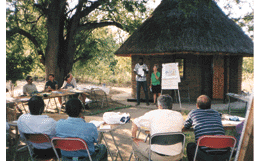 This page has been mothballed.
This page has been mothballed.
It is no longer being updated but we've left it here for reference.
Natural resource management within a multispecies system in the mid Zambezi valley.
- Collaborators
- CIRAD, France
- IICT, Portugal
- INDER, Mozambique
- University of Zimbabwe, Institute of Environmental Studies, Zimbabwe
- University of Zimbabwe, Department of Animal Science, Zimbabwe
- Macaulay Contact
 Many of the world's poorest countries lie in the arid and
semi-arid zone, where the connection between land degradation and resource use,
particularly livestock production, is acknowledged to be a major limitation to
the sustainable utilisation of these fragile ecosystems. In many regions of
Southern Africa pristine dryland habitats, which are rich in biodiversity, are
experiencing increased population pressure as a consequence of human
immigration due to national population growth and the removal of disease,
drought or human conflict. The development of sustainable resource use
strategies in these areas requires the development of a predictive
understanding of the constraints and opportunities for the development of
pristine habitats for multispecies (livestock/wildlife) enterprises.
Many of the world's poorest countries lie in the arid and
semi-arid zone, where the connection between land degradation and resource use,
particularly livestock production, is acknowledged to be a major limitation to
the sustainable utilisation of these fragile ecosystems. In many regions of
Southern Africa pristine dryland habitats, which are rich in biodiversity, are
experiencing increased population pressure as a consequence of human
immigration due to national population growth and the removal of disease,
drought or human conflict. The development of sustainable resource use
strategies in these areas requires the development of a predictive
understanding of the constraints and opportunities for the development of
pristine habitats for multispecies (livestock/wildlife) enterprises.
The primary limitation to the sustainable utilisation of natural resources in the drylands of Africa is an understanding of the biological relationships between climate, soils, plants and animals under socio-economic constraints. Using a multidisciplinary approach (ecologists, agronomists, geographers, economists and sociologists) this project is developing a holistic understanding of the resource use and animal production systems in the mid-Zambezi Valley (ZV; Zambia, Zimbabwe and Mozambique).
This project builds upon socio-economics based projects underway in the Guruve District of Zimbabwe to produce an integrated approach to assessment of the biological processes and functioning within this fragile ecosystem. Existing data is being collated on the biological functioning of semi-arid rangeland systems and on the major socio-economic determinants of natural resource use and management. Where specific information is lacking (Tete region of Mozambique and the Eastern Province of Zambia), field projects have been set up. These data will be incorporated into computer-based biological and socio-economics models. The final model will be coupled to a GIS in order to assess the spatial and temporal consequences of land use policy implementation at a range of scales (temporal 5 50 years; spatial 10 250 kms).
 The research will be
summarised as a set of Decision Support Tools for local decision makers and
will be disseminated using the CAMPFIRE programmes in Zimbabwe and Mozambique
and the ADMADE programme in Zambia which will be involved in all aspects of the
process. The economic benefits will be the increased, less variable and more
sustainable output from pastoral systems in the fragile ecosystems of the
mid-Zambezi Valley.
The research will be
summarised as a set of Decision Support Tools for local decision makers and
will be disseminated using the CAMPFIRE programmes in Zimbabwe and Mozambique
and the ADMADE programme in Zambia which will be involved in all aspects of the
process. The economic benefits will be the increased, less variable and more
sustainable output from pastoral systems in the fragile ecosystems of the
mid-Zambezi Valley.

